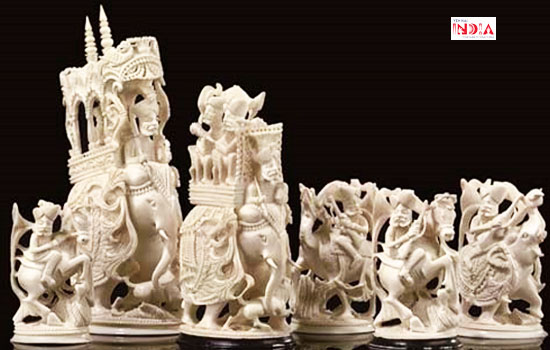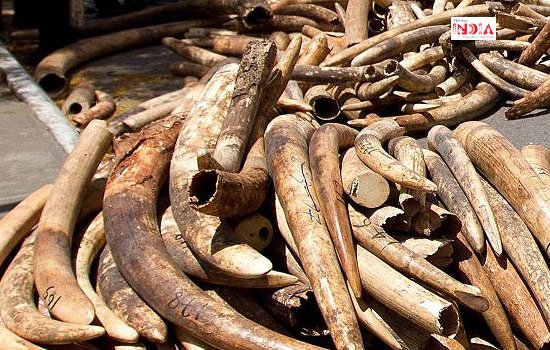Ivory Art is spread nearly all through India with every district having its own claim to fame. India, with its colossal elephant populace, has for quite some time been a focal point of ivory work.
Alongside spices and muslin, ivory positioned among the highest items looked for from India by rulers and squires of unfamiliar nations on antiquated occasions.

The ivory carvers of Jaipur, Bengal, and Delhi are known for their engraved models of ‘ambari hathi’ or processional elephant, bullock trucks, shoes, coffins, book covers, and carts. Let’s have a look at this art present in different states.
Recommended Story – Wood-Craft from different states of India
Ivory Handicrafts – Detailed Analysis State-Wise
ORISSA
There is an Orissan custom that offers ivory trimmed furniture to the Jagannath sanctuary at Puri. Small scale holy places with sensitive columns and perplexing help botanical work, coffins portraying scenes from fantasies and legends, and pictures of divine beings and goddesses have been a custom in Kerala and Karnataka.
Presently, the rundown of ivory items in well-known interest has spread to various products like chess sets, billiard balls, and articles like fragrance bottles, paper blades, knickknack or container boxes, and gems things like globules, dab neckbands, bangles, and rings, made generally in Delhi.
RAJASTHAN

Rajasthan is renowned for its ivory fans with alluring figures for handles and focal points for the feasting table. The ivory work on the entryways of the Amber Fort in Jaipur and the perfect in-lay in the Mysore Palace residence entryways and the Golden Temple at Amritsar declare the job of ivory in architectural decoration.
A short insight on Ivory Carvings of Rajasthan!
Ivory carving utilizing the tusks of elephants, is the most fragile specialty structure that has prospered under the grand support in hardly any authentic urban areas of Rajasthan including Udaipur, Jaipur, Bharatpur and Jodhpur.
One can discover various examples of this sort of fine art as charming sensitive ivory figures of Hindu divine beings and goddesses with exact moment cutting. On top of this, Jali-work of ribbon-like unpredictability is the declaration of the brightness of ivory carvers. Ivory cutting is certainly not another art for India; it has been around for over 4000 years in this country.
Ivory Carving: Most beautiful part of Rajasthani Culture

Ivory Cutting was well known even in the period of old and middle age regal states. The surface of ivory is smooth, and whatever plans the specialists want to make can be handily cut on ivory. Apart from entrancing beautifying things for show in family rooms, ivory bangles are one more unmistakable and mainstream thing in use.
The noteworthy art of Ivory cutting, presently restricted and for a valid justification as well, was maybe perhaps the most lovely piece of Rajasthan’s art culture.
Ivory Carving is as old as 4000 years!
As of now referenced, it is likewise maybe one of the most seasoned type of workmanship, as old as 4000 years of age at any rate, to have made due till current time. Indeed, notice of ivory cutting is even found in the most established Vedic sacred writings of India.
Also, Ivory cutting being a delicate material is ideal for cutting. Be that as it may, the non-abrasiveness of ivory additionally makes the cutting errand hard for the specialists, as the material is inclined to simple harm.
However, the wonderful shade of ivory has outperformed every one of these disservices, making the craftsmanship exceptionally well known among well-off individuals of all ages. Though typically viewed as a customary fine art of Rajasthan, ivory-cutting has been mainstream workmanship across the globe for ages.
Ban on Ivory- Carving?

All things considered, the artistic expression stays inseparable from Rajasthan. The state having a few august capitals sometime in the distant past like Bharatpur, Udaipur, Jaipur, Jodhpur, and Pali. These recorded urban communities were truth be told the center of this incredibly wonderful work of art.
However, The ban on ivory has shut down this industry. Numerous relics like masterpieces, chess pieces, weapon handles, jewelry, and even icons of Hindu gods made of ivory, however strangely costly, were accessible in plenitude in the spots referenced previously.
After the restriction on ivory by the public authority, the craftsman proceeded onward today to cutting antiquities utilizing horn and bone.
GUJARAT

Skilled workers of Gujarat cut stunning human figures as likewise pictures of deities. Uttar Pradesh is popular for its ivory results of gods, moving figures, and enlivening plaques.
KERALA

Kerala has dominated the field of painting on ivory. The state with its plenty of sanctuaries with breathtaking carvings demonstrates its wonderful workmanship.
The Scenes from the Ramayana and other epic stories and a sculpture of St. George on a goliath charger, executing the mythical serpent with his lance are a portion of the expert works of ivory demonstrate their creative accomplishment.
Recommended Story – Handicrafts in India – Checkout the variety and craftsmanship
How are Ivory Products made?

The heavenly carved elephant in Delhi is a great illustration of the complexity and delicacy of the ivory-cutting convention of northern India. Ivory is a thick substance covered with an external layer of unpleasant bark which must be taken out first.
Also, The item to be cut is first portrayed on the piece of ivory and an assortment of etches are utilized to cut the littlest of subtleties. The tusk is dunked in milk to relax it for simple cutting. Fragile cutting is finished utilizing an assortment of documents.
Moreover, The surface is first smoothened out by sandpaper and afterward dunked in methylated soul with a brush in the event that it is white or if yellow in water blended in with hydrogen peroxide which brightens it. Cutting involves efficient rejecting/scooping and etching of the materials from the center square.
Where does Ivory Carving happen in India?

Ivory is cut all over India, yet predominantly at Amritsar, Patiala in Punjab. Then at Behrampore and Murshidabad in Bengal. Also, in Surat, Ahmedabad, Damam, Balsar, and all through Southern Gujarat.
Moreover, in Satara and parts of Maharashtra. In the Southern part, ivory is carved in Kerala and Vishakapatnam. The subjects are lavishly caparisoned elephants, state gondolas in occasion trim, tigers, cows, and peacocks. Also, all cut as statuettes; and chasing, merry, and formal scenes, and legendary subjects carved in relief.
The carved ivory brushes are found in business sectors. Ratlam, in Western India, is known for its expensive ivory wristbands.
Now, that you know a lot about Ivory Handicrafts, share this piece of information with your friends and enjoy!
Also Read – Top 10 Online Handicrafts Stores In India










